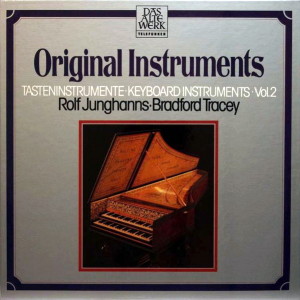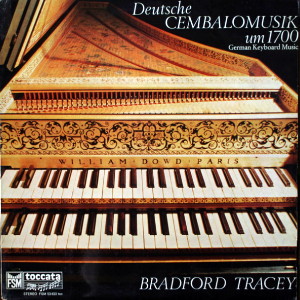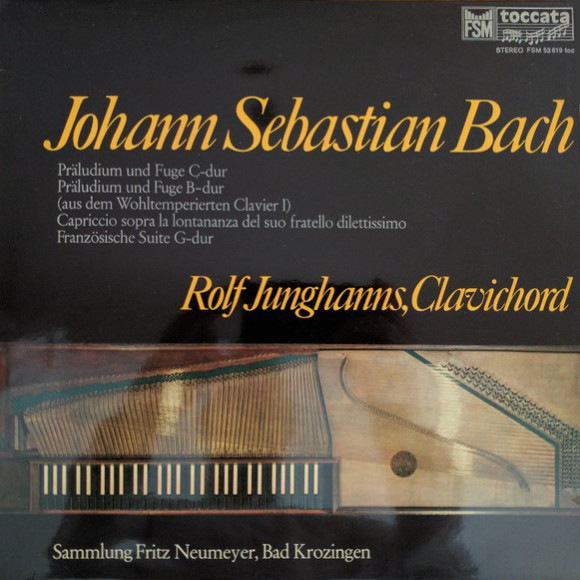 |
3 LP's
- Telefunken 6.35521 EK (p) 1980
|
 |
| 1 LP -
Toccata FSM 53 623 (p) 1976 |
 |
| 1 LP -
Toccata FSM 53 619 (p) 1975 |
|
| ORIGINALINSTRUMENTE -
Tasteninstrumente Vol. 2 |
|
|
|
|
|
|
|
|
Long Playing 1
|
|
|
|
| Dietrich Buxtehude (1637-1707) |
Präludium
und Fuge g-moll, BuxWV 163 |
|
8' 30" |
A1 |
| Friedrich Wilhelm
Zachow (1663-1712) |
Suite
h-moll |
|
9' 10" |
A2 |
|
-
Allemande · Courante · Sarabande ·
Fuga Finalis |
|
|
|
| Georg
Friedrich Händel (1685-1759)
|
Suite
d-moll - aus "Suites de Pièces
pour le clavecin", 2. Collection |
|
9' 19" |
A3 |
|
-
Allemande · Courante · Sarabande ·
Gigue |
|
|
|
| Johann Caspar Ferdinand
Fischer (um 1665-1746) |
Suite
VI D-dur - aus "Musicalisches
Blumen-Büschlein" |
|
12' 40" |
B1 |
|
-
Präludium · Allemande · Courante ·
Sarabande · Gigue · Bourée · Menuet |
|
|
|
| Johann Christoph Bach (1642-1703) |
Aria
mit 15 Variationen a-moll |
|
15' 50" |
B2 |
|
Long Playing 2 |
|
|
|
| Johann Sebastian Bach (um
1685-1750) |
Präludium
und Fuge C-dur, BWV 846 |
|
4' 43" |
C1 |
|
Präludium
und Fuge B-dur, BWV 866 |
|
4' 52" |
C2 |
|
Capriccio
über die Abreise seines geliebten
Bruders, BWV 992 |
|
13' 40" |
C3 |
|
Französische
Suite G-dur, BWV 816 |
|
22' 32" |
D1 |
|
-
Allemande · Courante ·
Sarabande · Gavotte · Bourée
· Loure · Gigue |
|
|
|
|
Long Playing 3 |
|
|
|
| Johann Sebastian Bach (um
1685-1750) |
Toccata
d-moll, BWV 913 *
|
|
13' 42" |
E1 |
|
-
(Allegro moderato) · (Presto) ·
Adagio · Allegro |
|
|
|
|
Toccata
G-dur, BWV 916 *
|
|
8' 04" |
E2 |
|
-
(Presto) · Adagio · Allegro |
|
|
|
|
Triosonate
Es-dur, BWV 525 **
|
|
13' 53" |
F1 |
|
-
Allegro |
2' 53" |
|
|
|
-
Adagio |
7' 02" |
|
|
|
-
Allegro |
3' 58" |
|
|
|
Triosonate
c-moll, BWV 526 **
|
|
10' 49" |
F2 |
|
-
Vivace |
3' 53" |
|
|
|
-
Largo |
3' 03" |
|
|
|
-
Allegro |
3' 53" |
|
|
|
|
|
|
|
|
|
Bradford
TRACEY *
|
Bradford
TRACEY
|
Rolf JUNGHANNS
|
Rolf
JUNGHANNS & Bradford TRACEY **
|
|
|
|
Buxtehude / Zachow / Händel
/ Fischer / J. C. Bach (Long Playing 1)
|
J. S. Bach (Long Playing 2)
|
J. S. Bach (Long Playing 3) |
| -
Cembalo nach Ruckers, Antwerpen um
1620, von William Dowd |
-
an zwei
Clavicord-Originalinstrumenten aus
der Sammlung Fritz Neumeyer, Bad
Krozingen |
-
Cembali nach Blanchet, Paris um
1730, von William Dowd, Paris
|
|
|
|
|
Luogo
e data di registrazione |
|
Schlos
Bad Krozingen (Germania) - 1976 (Buxtehude,
Zachow, Handel, Fischer,
J.C. Bach)
Gobelinsaal,
Markgrafenschloss, Ansbach
(Germania) - luglio 1975
(J.S. Bach, long playing 2)
|
|
|
Registrazione:
live / studio |
|
studio |
|
|
Recording
Supervision
|
|
Paul
Dery |
|
|
Edizione LP |
|
TELEFUNKEN
- 6.35521 EK - (3 LP's - durata
55' 29", 45' 47" & 46' 28") -
(p) 1975/76/80 |
|
|
Originale LP
|
|
TOCCATA
- FSM 53 623 - (1 LP - durata
55' 29") - (p) 1976 -
Analogico (Buxtehude, Zachow,
Handel, Fischer, J.C. Bach)
TOCCATA - FSM 53 619 - (1 LP -
durata 45' 47") - (p) 1975 -
Analogico (J.S. Bach, long
playing 2)
TELEFUNKEN - 6.35521 EK - (3°
LP - durata 46' 58") - (p)
1980 - Analogico (J.S. Bach,
long playing 3)
|
|
|
Prima Edizione CD |
|
FSM
Adagio - FCD 91 619 - (1 CD -
durata 45' 47") - (c) 1991 -
AAD (J.S. Bach, long playing
2)
|
|
|
Note |
|
Production
by Toccata.
|
|
|
|
|
German
Keyboard Music
ca. 1700
While the
17th century saw
the development of
distinct national
keyboard styles in
both France and
Italy, a 17th
century German
keyboard style
defies definition.
We are immediately
presented with a
long and varied
list of composers
- each with his
own personal and
distinctive
approach to the
keyboard. There
were those more
travelled
composers, such as
Froberger, Kerll
and Muffat who
ventured to learn
the new styles
first-hand from
such masters as
Chambonnières and
Lully in France
and Frescobaldi in
Italy. But there
were those, who,
bound by duties at
court and church,
remained at home
and absorbed what
innovations came
their way -
incorporating both
the old and new
into their own
personal style.
Perhaps one of the
best examples of
such a 17th
century composer
is Dietrich
Buxtehude. While
his keyboard
suites are in
predominantly
French style, his
organ works are a
mixture of all
existing styles of
the day. The
Prelude and Fugue
in G minor, with
its contrasting
rhapsodie and
strict sections,
reminds us of a
Froberger or Rossi
toccatas, while
the playful
rhythmic
juxtapositions
echo Sweelinck,
John Bull and the
variation
techniques of
Elizabethan
England. Like the
Frescobaldi and
Froberger
toccatas, it lends
itself well to
performance on
both the organ and
the harpsichord.
Friedrich Wilhelm
Zachow, who has
been practically
forgotten as a
composer, is
remembered today
chiefly as
Handel's teacher.
Although most of
his keyboard works
have been lost,
his suite in B
minor, the only
existing suite, is
one of the
masterpieces in
the 17th century
keyboard
literature. That
Handel quoted the
theme from the
Fuga Finalis in
one of his
Concerti Grossi
shows the impact
it had on his
young pupil.
Handel’s Suite in
D minor - though
published in 1733
- can well be one
of the suites he
wrote while under
Zachow’s tuition
during those early
years in Halle.
Johann Caspar
Ferdinand Fischer,
composer to the
Markgraf of Baden,
was a devote
francophile. His
Pièces de
Clavecin, or
Musicalisches
Blumen-Büschlein,
published 1696,
contain a few
suites ordered
after Froberger,
but mostly Lullian
"ballet" suites
with an assortment
of gavottes,
bourrées, menuets,
passepieds and
rondeaus.
According to
Forkel, Fischer
was one of the
composers Johann
Sebastian Bach
studied during his
stay in Ohrdruf.
Indeed, Fischer’s
influence on Bach
is not to be
underestimated.
His Ariadne Musica
of 1717 served as
a model for Bach’s
Well Tempered
Clavier, while the
close link between
the prelude from
the D major suite
and Bach's B flat
prelude from the
WTC I is evident.
The recent
recovery of Johann
Christoph Bach’s
long lost Aria
with 15 Variations
presents us with
another major
composition which
directly
influenced Johann
Sebastian Bach.
Christoph Bach, a
cousin of Johann
Sebastian Bach’s
father Ambrosius,
is the most
significant member
of the Bach family
before Johann
Sebastian. Born in
Arnstadt, he
worked later as
organist in
Eisenach and
harpsichordist and
chamber musician
to the ducal
chapel. The close
parallels between
this profound work
and Johann
Sebastian Bach's
Aria variata alla
maniera italiana
proves Sebastian's
knew and studied
the work well.
Johann
Sebastian
Bach: Music
for Clavichord
and
Harpsichord
While the
harpsichord plays
a significant role
in the modern
interpretation of
Johann Sebastian
Bach's keyboard
works, the
clavichord remains
almost forgotten,
although it was as
widespread in the
17th and 18th
centuries as the
harpsichord. It
possesses a number
of advantages: it
is small, light,
easy to transport,
has a reliable and
simple mechanism
as well as a
pleasant tone
capable of the
finest of nuances.
It’s major
disadvantage is
its extremely
gentle tone which
makes an ensemble
performance, as
well as one before
a larger audience,
almost impossible.
We can probably
account this as
the main reason
for its slow
"rediscovery".
The most-quoted
verification for
the use of the
clavichord
originates from
the first Bach
biography by
Johann Nikolaus
Forkel, 1802:
"He
(Johann
Sebastian
Bach) liked to
play on the
clavichord
best of all
... He thought
the clavichord
to be the best
instrument to
study by as
well as for
private
musical
entertainment.
He found it
most
appropriate
for the
interpretation
of his finest
musical ideas,
and didn't
believe it
possible to
produce such a
manifold
variety of
shading at the
harpsichord or
pianoforte as
at this quiet
but pliant
instrument."
Forkel
supports himself
with reports from
Johann Sebastian
Bach’s sons, Carl
Philipp Emanuel
and Wilhelm
Friedemann, both
of whom were
famous clavichord
players at a time
when the
clavichord was,
without a doubt,
the most popular
keyboard
instrument. For
this reason is
Johann Sebastian
Bach's preference
for the clavichord
not clearly
proven, but we can
nevertheless be
sure that Bach
played the
clavichord and
valued it highly.
Johann Sebastian
Bach probably
composed the seven
toccatas for
harpsichord in
Weimar between
1708 and 1717.
During this period
Bach had renewed
his interest in
Italian music and
wrote his
transcriptions of
string concertos
by Vivaldi and
other composers.
Thus, in the G
major toccata
certain powerfully
descending triads
in the first
movement resemble
"performance modes
which more
frequently occur
in the piano
transcriptions of
Vivaldi" (Spitta).
Furthermore, the
first bars of the
tutti concept
recall the second
allegro movement
in Vivaldi’s B
minor concerto.
Altogether the G
major toccata
features the three
movement structure
of the typical
concerto grosso,
and even in the
opening allegro
the characteristic
alternation
between solo and
tutti.
The trio sonata
with two upper
parts and
thoroughbass (bass
part as well as
fill-in chords)
was the most
assiduously
cultivated genre
of chamber music
in the 18th
century. The upper
parts were played
on two violins,
two flutes, two
oboes or also in
mixed
combinations, with
the bass
instrument cello,
viola da gamba or
bassoon, and
harpsichord, lute
or choir organ
providing
harmonious
support. In this
way four
performers were
involved in the
rendering of a
trio sonata.
In addition, it
was also customary
for two performers
to play trios,
with only one
melody instrument
and obbligato
harpsichord. The
latter was
responsible for
the second melody
part as well as
the bass part.
That these
different manners
of performance
existed side by
side with each
other is shown by
the example of the
trio sonata in G
major by Johann
Sebastian Bach
which is available
in two versions:
in one case for
two transverse
flutes with
thoroughbass, and
the other for
viola da gamba
with obbligato
harpsichord. If
the trio sonata
were then
entrusted
completely to the
keyboard
instrument, other
possibilities of
performing it
again resulted.
The three-part
element could be
represented either
by only one of the
players on one
instrument with
two manuals and
pedal (organ,
pedal harpsichord
or also pedal
clavichord), or
the music was
played on two
harpsichords,
spinets or
clavichords in the
manner as
described by
Francois Couperin
in the foreword to
his grand trio
"L'Apothéose de
Lulli" (1725):
"This
trio, just
like the
'Apothéose de
Corelli', and
the whole
collection of
trios which I
intend to
publish next
july, can just
as well be
played on two
clavecins as
on all other
instruments.
In my family,
and with my
pupils, I
perform it
with a great
deal of
success with
the upper part
of the bass
being played
on the one
clavecin
(harpsichord)
and the second
on the other,
with the same
bass in
harmony. Now
the situation
here is that
two copies are
needed for
this instead
of one, as
well as two
clavecins. For
the rest,
however, I
find that it
is often
easier to
bring these
two
instruments
together than
four people
who make music
... The
performance
will result in
a not less
pleasant
impression,
especially
since the
clavecin in
its way has a
brilliance and
clarity which
one can
scarcely find
with other
instruments."
Two of the
six so-called
organ trio sonatas
by Johann
Sebastian Bach are
played here in
accordance with
Couperin’s
directions. From
the intermediate
position between
organ and chamber
style, Philipp
Spitta concluded
that these unique
masterpieces,
which Bach wrote
as practice pieces
for the organist
training of his
eldest son Wilhelm
Friedemann, were
intended for the
pedal harpsichord
or pedal
clavichord.
|
|
|

